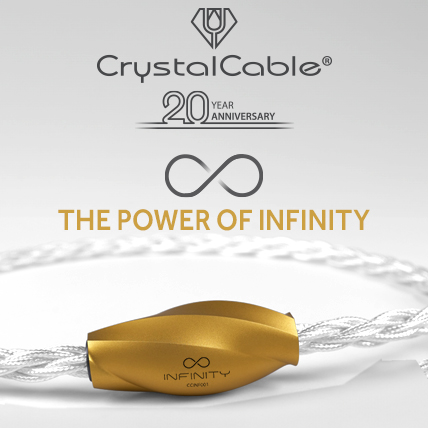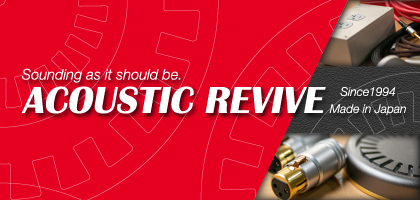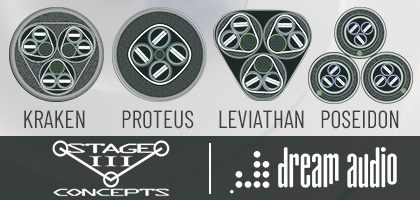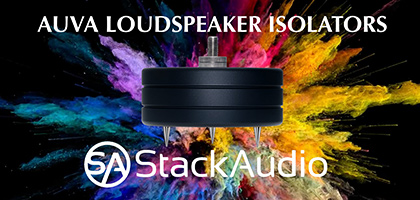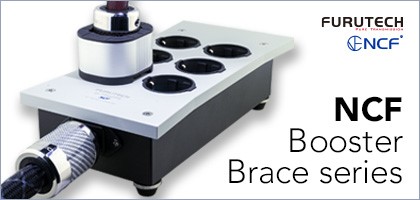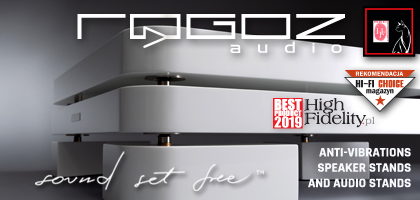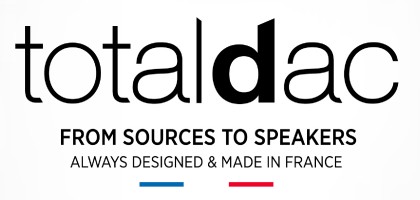No. 259 December 2025
- COVER REVIEW: LUMEN WHITE Altai ⸜ loudspeakers » AUSTRIA
- COVERAGE ⸜ audio show: HIGH FIDELITY on Audio Video Show 2025. A few worlds about time… » POLAND
- REVIEW: ACOUSTIC REVIVE Absolute Power Cord-K ⸜ power cable AC » JAPAN
- REVIEW: ANCIENT AUDIO Lektor 30th Anniversary ⸜ CD player » POLAND
- REVIEW: HAIKU-AUDIO Sol2 Pro ⸜ integrated amplifier » POLAND
- REVIEW: NORSE AUDIO X1 & X5 ⸜ power amplifier • stereo & power supply DC » SWEDEN
- REVIEW: SME Model 35 + Model Vi ⸜ turntable + tonearm » GREAT BRITAIN
- REVIEW: TiGLON MZ-Grande ⸜ anti-vibration feet » JAPAN
- REVIEW: THUNDER MELODY Ground Hub Black Edition ⸜ anti-vibration platform & ground unit » POLAND
- REVIEW: WK AUDIO TheRay Basic ⸜ analogue interconnect RCA » POLAND

|
Editorial
text by WOJCIECH PACUŁA |
 |
No 259 December 1, 2025 |
|
THE 19TH INTERNATIONAL FRYDERYK CHOPIN PIANO COMPETITION IN BINAURAL
...it is progress, no matter how you look at it. It does not take long to find information that Polish Radio was already present with its microphones at the Warsaw Philharmonic Hall during the first edition in 1927 and that from the very beginning it has been awarding its prestigious prize for the best performance of Chopin's mazurkas. It is therefore an important part of the event itself. Incidentally, the first winner was a Russian, Lev Oborin, and Dmitri Shostakovich was also among the representatives of the USSR. 
⸜ Broadcasts of the pianists' performances have been available online since 2015 – this year, they are also available in binaural version on the player; the only exception were the final performances with the orchestra. Anyway, it is one of the most important music festivals Made in Poland. When we look at the popularity of both the event and the composer himself in many countries around the world, it is not difficult to understand that this is how so-called “soft power” works. We have become accustomed to the fact that Poland is not its center and that it is the US, and now also Korea and other countries outside the European cultural circle, that are its custodians. And the Chopin Competition turns out to be its fantastic source and vehicle. And this cannot be overestimated. It works slowly, it is not spectacular, but it lays the foundations for many other initiatives. It is an underlying force, invisible, yet exceptionally strong and constant over time. After all, both the victory of Li Yundi, winner of the 14th edition in 2000, representing China, and Bruce (Xiaoyu) Liu, winner of the 18th Chopin Competition in 2021, who is Canadian but has Chinese roots, caused almost euphoria in the Middle Kingdom and a real boom for Chopin, and thus for the country where he came from. It was no different with Korea and its representative, Seong-Jin Cho, who took first place in the 17th edition of the event in 2015. As we have already written, this event caused an extraordinary, unprecedented increase in piano sales in the country and a proliferation of schools teaching how to play them; the interview with the Korean in “High Fidelity” was the first conversation with him after winning the competition; more → HERE. ... as I say, it’s our most important asset at the moment, but one with extraordinary impact. Other cultural events, works of art, and even politics also “ride on the coattails” of its success. It must be said that the success was due to both the music and the widespread promotion of the event across all possible channels. The presence of the Competition on TikTok, in full broadcasts rather than short clips, may seem bizarre, but it was the first exposure to Chopin's music for many young people. My daughter-in-law says that she now understands how her young college friends know about this event and even comment on it, even though they are not interested in classical music. 
⸜ Eric Lu. 19th International Chopin Competition. Warsaw, October 16, 2025 • photo: Krzysztof Szlęzak/NIFC press materials The visual aspect of this spectacle is extremely important. It builds – nomen omen – the image of the pianists' struggles, and it also creates stars. After his victory, Bruce Liu went on a world tour, and Deutsche Grammophon did not wait long to release a recording of his concert, as it appeared just a few weeks after the end of the competition. The musician himself said that he “feels like a rock star”; more about him and the Fazioli piano → HERE. Yes, social media can promote even classical music... ... they feed on images. This year, the number of memes related to the event was probably the highest in history, and most of them mocked the sudden love of Poles, their deep knowledge and subtle distinctions that guided them in choosing their favorite, regardless of age, gender, religion, views, cultural background, etc., to the Master's music. Add to this the broadcasts of all stages of the event on YouTube, replays, and special programs, and we get a huge amount of visual material. However, historically speaking, the best way to experience these events was listening to the radio. It is a very good way to absorb music, paradoxically much more emotionally engaging than watching it. And this year, the most exciting way to participate in it, apart from sitting in the chairs of the National Philharmonic, was the broadcast of Polish Radio Program II with binaural sound. I stumbled upon this information by accident, but perhaps that was because I didn't read the announcements before the event very carefully. Both the press spokesman and all the organizers' materials mentioned it. On the official website of Polish Radio, there is a separate tab entitled: Feel like you're at the National Philharmonic! The Chopin Competition in binaural sound; more → HERE ˻PL˺. The materials often mentioned that it was the highest quality sound, sometimes adding that “it is intended for audiophiles.” 
⸜ The Chopin Competition is not only about music, but also the whole sphere surrounding it, including scandals. Such as the exclusion of Ivo Pogorelić in 1980; pictured is the pianist's latest album, featuring sonatas by Beethoven and Rachmaninoff in Blu-spec CD2 (BSCD2) format. I don't know, maybe I'm wrong, but I think this is the first such clear statement. In the sense that someone from the world of music has done something for our industry. If you were to talk to a random music student, whether a musician or a musicologist, if you were to ask (almost) any lecturer about it, and then add to that the graduates of the directing, production – or whatever it's called – faculty and use the word “audiophile” in that conversation, the response will almost certainly be a grimace of disgust, a wave of the hand, or perhaps even some clever insult that shows both the interlocutor's contempt for this group and allows him to show his superiority. So the appearance of the term “audiophile” in widespread publicity, and in a positive, even “exemplary” context, came as a surprise to me. It may be a temporary fad, a blip, an unintentional mistake, but perhaps we are dealing with a critical mass and the audiophile way of listening to music, i.e., perfectionist, has ceased to be esoteric and has become part of the mainstream. Its premium part, but still. To save you the trouble, I will just say that binaural recordings (broadcasts) require the use of headphones. Chesky Records has developed a special system for converting this type of recording for speakers, but generally speaking, headphones are required. Two microphones, usually omnidirectional, are used for recording, placed in a so-called dummy head. It has contoured ears, nose, and head, sometimes also a torso, designed to mimic the head of a real human being. This allows the signal to be modified using HRTF. We interpret this signal as if we were sitting in the recording location and our ears were perceiving this space. This year marks the 130th anniversary of the first transmission using headphones. In 1895, thanks to the Electrophone system, it was possible for the first time to listen to live music played at the local opera house, also using headphones connected to a telephone line. The system operated on a subscription basis and offered listening sessions on Sundays. In addition to musical performances, it was also possible to order a broadcast of a church service from the local church. It was the first... ... Polish Radio's idea of binaural broadcasting was therefore three times successful. First (although PR materials do not mention this in this context) – consider the aforementioned anniversary of the first broadcast using headphones. Second, the 100th anniversary of Polish Radio's first broadcast. And thirdly, the Chopin Competition. Together, they add up to something much greater than the simple sum of their parts. Because, as I'm sure you'll agree, people today listen to music not only in their cars, but also through headphones. 
⸜ The scandal involving Pogorelić, representing Yugoslavia, was publicized by the ostentatious protest of Martha Argerich, winner in 1969 and member of the jury; pictured is her album of music by Chopin and Liszt, conducted by Claudio Abbado, on the cover. So I would sit down in the morning to write, and in the afternoons and evenings I would relax with my headphones on. I wasn't the only one, as far as I know. As soon as I found out about this possibility, I sent the information to Hisao Natsume, the head of the Sakuraphon record label, who immediately went to the Polish Radio website and started listening to the competition in this very way. After a short time, he asked me to recommend some good Bluetooth headphones, because he was delighted with the binaural transmission and wanted “more.” And we are talking about a lover of Chopin listened to from 78 rpm records (!); more → HERE. By the way, Hisao-san is currently working on a reissue of an album by Japanese pianist Kazuo Yasukawa, who grew up in France and was a student of Lazare Lévy. And since he has just met Mietek Stoch in Tokyo, who brought him some interesting records from Poland, including pre-war Muza recordings, we may soon see a CD reissue of recordings by Jerzy Lalewicz, a student of Anna Essipowa. So we can probably expect... |
... participating in the competition in this way was a special experience for me. Leaving aside for a moment the emotions associated with music and musicians, and yet in the KSS group we were exchanging our tips and favorites, the sound obtained in this way was really high quality. It had been a long time since I had heard such a realistic-sounding piano. This made it easy to hear the differences between Fazioli, Steinway, and Kawai. In contrast to listening via the Internet, Rysiek B., whom you probably know from meetings of the Krakow Sonic Society, lobbied for listening in mono, through vintage tube receivers, of which he is an admirer and collector. However, technology is against him. It is important to note that analog radio has been gone for years. Although transmission still takes place on radio waves, and is therefore analog, the signal in the studio is entirely digital and heavily compressed. That is why binaural transmission, available only via the Internet, seemed to me to be the best. And that's with a simple set-up, with my Samsung A52 smartphone and Final ZE8000 Jibun Dummy Head headphones; more → HERE. It quickly became apparent that this was a “raw” broadcast, meaning unedited, without breaks, with microphones permanently open and continuous transmission from the beginning to the end of the concerts. There was something incredibly refreshing about it. After a while, I caught myself listening not only to the music, but also to the breaks between performances, with the sounds from the hall, conversations, chairs being moved, etc. It calmed me down very, very much. 
⸜ „Dummy head” Neumann KU-100 • photo from Neumann press release When I wanted to listen to Przemysław Psikuta and his guests, I switched to the official broadcast; all I had to do was press the button next to the one marked “Binaural broadcast.” But more and more often, I stayed in the room with its “white noise.” A note for the future—maybe it would be worth setting up Neumann's “dummy head” in the “press lounge” and listening to the discussion as if we were sitting there with the speakers? This is because it sounded extremely realistic. Of course, if even better A/D converters, such as those from dCS or Bricasti, were used after the microphone preamplifiers, it would be even better, and if it were a DSD format transmission, it would be even better too. But there is no point in complaining, because it was very good. When I listened to excerpts from speeches quoted by the editors during the breaks, I had no doubt that the binaural transmission was... ... I was painfully surprised to discover that no one was in charge of this broadcast. Opening such a “window” to the Philharmonic Hall is great. But even such an approach, which is non-interfering, must be carefully prepared and supervised in order to work. As it happens, the things that look unprepared require the most work. The thing is that, in order to save themselves trouble, the Polish Radio producers inserted a so-called gate into the signal path. This particular gate did one thing: when the signal dropped to a set level, it was muted by a few decibels – I assume by about 5-8 dB. Thanks to this solution, when nothing is happening on stage, the whole thing is muted. Gates of this type are used during concerts. I use them myself, mainly for vocal microphones, sometimes for percussion instruments. The idea is to avoid unnecessarily increasing the amount of noise in the signal output. Such a gate can be set to a mute level, an activation level, the time it takes to respond to a signal, and the time it takes to mute it. It's a really helpful tool. But not in this case. As a result of its use during breaks, but also during quiet parts of the performances, the signal would suddenly disappear and then return after a moment. It was annoying as hell! This gate also worked during regular stereo broadcasts, but it was particularly annoying in binaural transmission, where we have a lot of information about acoustics, i.e., low-level information. Much more so than the coughing of viewers during breaks, to mention one of the scandals of this year's competition. 
⸜ That’s how a gate work • fig. → IAINF, CC2.0, accessed: 20.10.2025 Without it, one could even forget that there are no comments here, that the announcers' voices are also heard from the hall and not directly from the line, that no one really cares about this broadcast except us, the listeners. And so – a fantastic thing that turned out to be a curiosity that Radio forgot about the moment it announced it. What's more, and I'm listening to Canadian Kevin Chen right now, concerts featuring the orchestra were no longer broadcast binaurally – the button for this broadcast disappeared from the radio player. Anyway, it would have been possible to come up with a cool logo, right? It would also have been possible to inform audiophiles that such a possibility existed by sending relevant information to magazine editors, and there are quite a few of them. It was a matter of classic target audience acquisition. In Poland, this may only amount to a few tens of thousands of people (readers), but these are people of “influence” who are authorities for their families and friends, which gives a fairly decent number – the number of people who might be interested in such information could be counted in the hundreds of thousands. Because, as I say, almost everyone today listens to music, podcasts, radio plays, and audiobooks through headphones. For them, binaural transmission would be a discovery of a completely different universe. Such concerts could then be released on CD (gold?, UHQCD in Japan?), or maybe even SACD – especially for audiophiles. By the way, I wonder if the aforementioned gate was closed before sending signal from the mixer or at the transmission stage. If before, then the recorded signal would be permanently contaminated by it and therefore defective. In short, it is a potential source of promotion and money. Every magazine, led by High Fidelity, would gladly take patronage of such an edition and engage in promoting either the concerts themselves or, later on, the recordings. They could be released on CD (SACD) and as files, and maybe even, crazy idea, on LP with a multi-microphone and binaural version. Do you remember the Zenph Studios albums from the „Zenph Re-Performance” series, released by Sony, which featured both versions of the recordings? An excellent idea, it's a shame it was abandoned after four titles. Why not do the same with Chopin and the broadcasts from the National Philharmonic? 
⸜ Glen Gould in binaural recording? – Here you go, Goldberg Variations played from a perforated tape recorded by the musician himself in 1955; Record Label: Sony BMG Music Entertainment, recorded directly in DSD Well, okay—I got carried away, because it's like killing the goose that lays the golden eggs, to quote a pre-TikTok meme, which was more verbal than visual, originating from Juliusz Machulski's comedy Kiler-ów 2-óch (1999), is a rare skill. However, so as not to end this text on a negative note, I will add that the most important thing is what I already mentioned: the binaural transmission took place. It was of high quality. It was aimed at audiophiles. And it delighted people not only in Poland but also around the world. Take Japan, for example, where games, manga, and anime related to Chopin were created. One example is Piano no Mori (The Piano Forest) by Makoto Isshiki – 26 volumes – and a feature film in 2007 directed by Masayuki Kojima (Madhouse studio), followed by a TV series in 2018-2019; more → HERE ˻PL˺. Because Chopin is our “gold” and a source of strength that we can use to influence people from many countries. It is therefore worth considering every aspect of this message, because it is the details that create an internally consistent message. Consistent, meaning good. And that is what we all want, after all... ● 
It is the last issue of HIGH FIDELITY in this year It means, Xmass and New Year ahead. |
About Us |
We cooperate |
Patrons |
|
Our reviewers regularly contribute to “Enjoy the Music.com”, “Positive-Feedback.com”, “HiFiStatement.net” and “Hi-Fi Choice & Home Cinema. Edycja Polska” . "High Fidelity" is a monthly magazine dedicated to high quality sound. It has been published since May 1st, 2004. Up until October 2008, the magazine was called "High Fidelity OnLine", but since November 2008 it has been registered under the new title. "High Fidelity" is an online magazine, i.e. it is only published on the web. For the last few years it has been published both in Polish and in English. Thanks to our English section, the magazine has now a worldwide reach - statistics show that we have readers from almost every country in the world. Once a year, we prepare a printed edition of one of reviews published online. This unique, limited collector's edition is given to the visitors of the Audio Show in Warsaw, Poland, held in November of each year. For years, "High Fidelity" has been cooperating with other audio magazines, including “Enjoy the Music.com” and “Positive-Feedback.com” in the U.S. and “HiFiStatement.net” in Germany. Our reviews have also been published by “6moons.com”. You can contact any of our contributors by clicking his email address on our CONTACT page. |
 


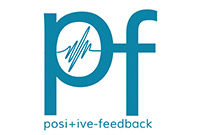
|
   |
main page | archive | contact | kts
© 2009 HighFidelity, design by PikselStudio,
projektowanie stron www: Indecity
